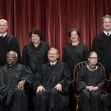If Joe Biden were to secure the presidency, he would face a scene not unlike President Franklin D. Roosevelt’s late-1930s America. The nostalgic similarities have some wondering if a Biden presidency, too, might seek to rework the lifetime-tenured, nine-Justice stalwarts of the U.S. Supreme Court.
In the shadow of the Great Depression, FDR faced a grim nation marked with economic scars and unemployment rates only rivaled by 2020’s numbers. The country was in need of reform and recovery, so the president introduced a welcome catalog of acts called the New Deal to provide benefit and relief to the American people. This package included the National Recovery Administration (NRA), the Social Security Act (SSA), the beloved Agricultural Adjustment Act (AAA), the Securities and Exchange Commission (SEC)—the list of FDR’s acronymic handiwork stretches on. The assortment of progressive policies earned FDR one of the best public opinions in presidential history and secured him a second term with a landslide victory in 1936.
Roosevelt’s popularity did not, however, lock in success. A U.S. president can gain widespread support for himself and his policies, as FDR did; the nation can elect a plethora of partisan representation to populate the Senate and House of Representatives, as Democrats did at the time; but the judicial branch, wielding the power of judicial review to keep their federal counterparts in check, can fester in their seats for years while hindering potential evolution.
Judicial review is the Supreme Court’s ability to review—and potentially invalidate—government acts to determine if they are constitutionally sound. The power was established in Marbury v. Madison in 1803 when the Court first ruled that an Act of Congress was unconstitutional. “It is emphatically the duty of the Judicial Department to say what the law is,” said Chief Justice John Marshall. “Those who apply the rule to particular cases must, of necessity, expound and interpret the rule. If two laws conflict with each other, the Court must decide on the operation of each.”
In the 1930s, the Supreme Court was dominated by opponents to FDR’s agenda: Justice Owen Roberts, nominated by FDR’s Republican predecessor, and the so-called “Four Horsemen,” a quartet of conservative justices that the media likened to the co-stars of the Apocalypse on a quest for the blood of Roosevelt’s New Deal legislation. Their perpetual 5-4 majority struck down Roosevelt’s policies, ruling them unconstitutional and, subsequently, void.
As the president’s celebrated list of acronyms fell to rulings of the Court, public opinion shifted. However, Roosevelt’s relief initiatives were treasured by the healing nation, and the nation was seething. After such a slew of undeniably inequitable decisions from the Court undermining progressive social change, the non-partisan veneer of the Court was cracking, and an opportunity arose from the discontent.
FDR introduced the Judicial Procedures Reform Bill of 1937 to Congress, a proposal to let the
President appoint up to six additional seats to the Supreme Court if a Justice had not retired by age 70. There were additional provisions for appointing dozens of federal judges to the lower courts. This “court-packing plan” to temper the conservative Court rulings was met with dispute, but it was still expected to pass on account of Roosevelt’s support base.
The Founding Fathers wrote the Supreme Court and federal courts into existence with Article III of the U.S. Constitution. Article III dictated some restrictions as intended safeguards on the balance and independence of the Court, such as that judges should “hold their offices during good behavior,” which is typically interpreted as the lifetime tenure federal judges enjoy. The intent for the judicial branch to check the executive and legislative branches was clear, but much of the practical execution was left to Congress to negotiate, vote on and implement like it would any other law.
The Supreme Court underwent several structural adjustments since its conception, seating between five and ten Justices until after the Civil War. Congress then passed the Judiciary Act of 1869 to configure the Court as it is today: one Chief Justice and eight Associate Justices who are, like all federal judges, nominated by the President and subject to the Senate for confirmation.
Amending the U.S. Constitution is an arduous task, but since it left the Supreme Court’s details to Congress, changing the number of seats or imposing term limits would not require a constitutional amendment. Perhaps the Founding Fathers left it open as such because they anticipated it needing to adapt over the years to keep partisanship at bay.
Regardless, the Court seemed to understand the potential for generations of conservative influence at stake if Roosevelt succeeded with changes to “pack” fresh, liberal judges into the judiciary. The proposal was a daunting enough possibility to sway the Court’s path, beginning with Roberts. He proceeded to contradict his own past opinions and helped FDR’s New Deal finally find support from the bench. Roberts’ transformation, along with the retirement of one of the “Four Horsemen,” was enough to turn the tide for the President’s policies. The Court appeared balanced enough again for the country to move past the ordeal; Roosevelt’s Supreme Court bill to supplant the elder Justices faded away.
In a maneuver similar to that of Justice Owen Roberts in 1937, current Chief Justice John Roberts has also been tempering his notoriously conservative opinions, generating curiosity that he may not be as conservative as everyone believed. Trump-nominated Justices Brett Kavanaugh and Neil Gorsuch have also bent left just flexibly enough in certain rulings to maintain the overall image of impartiality. At least superficially, such tactics perpetuate confidence that the Supreme Court is beyond politics, independent and fair above all else.
Advocates of modifying the Supreme Court today still see an unfair Court that could be enriched by additional opinions—preferably progressive ones. Today’s judicial landscape is bleak for the Democratic Party, and a Biden presidency would have to wrestle with nearly 200 federal judges appointed by President Donald Trump, including two Supreme Court Justices. Trump’s lineup showcases four consistent qualities: his appointees are conservative, relatively young, and predominantly white (165 of Trump’s nearly-200 judges are white). And out of the last 19 Supreme Court Justices, 15 have been nominated by Republicans. Now, the widespread relative youth of Trump’s installments will ensure the federal judiciary will resound with deep-rooted conservative ideology for decades.
“Appointing and confirming these strict constructionists to the courts, who are in their late 40s or early 50s,” Senate Majority Leader Mitch McConnell said in a radio interview, “We’re making a generational change in our country that will be repeated over and over and over down through the years.”
Though the executive branch cannot order changes to the Supreme Court, the president could take steps similar to FDR’s to propose legislation to Congress—but in this case, it would be more likely that members of the House and Senate would propose such a bill themselves. Biden is known for being tough on Republican-appointed judges during his time on the Senate Judiciary Committee, investigating nominees like Robert Bork and now-Chief Justice Roberts. However, in a 2019 debate, Biden shut down the idea, worrying that changes could cause the courts to lose the credibility that is paramount to a successful judicial branch.
The Court’s success depends not only on having a fair and impartial nature but on its ability to secure the public’s faith in its integrity. Despite witnessing extreme partisanship commandeer national and local politics against the backdrop of the worst economic crisis since the Great Depression, American democracy still clings to the idea of the Supreme Court as sacrosanct and trembles at the thought of disturbing its independent nature. If the federal courts have become as partisan as some fear, tinkering with their configuration may prove a worthwhile endeavor if the nation produces a Democrat-controlled Congress to undertake it.






